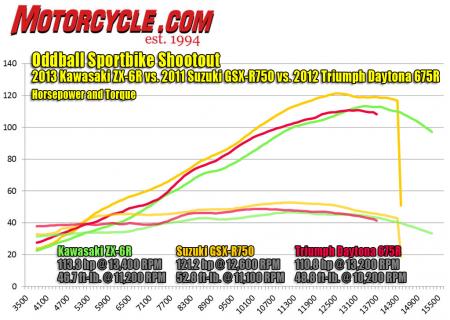2013 Kawasaki ZX-6R Vs. 2012 Suzuki GSX-R750 Vs. 2012 Triumph Daytona 675R - Video - Motorcycle.com
In 2011 we pitted the Ducati 848 EVO, Suzuki GSX-R750 and Triumph Daytona 675R against each other both on the track and street to find the king of the middleweight sportbike category. By the numbers, Suzuki’s GSX-R750 emerged the winner in both arenas, but the Triumph tugged at our heartstrings throughout. Oddly, despite having the largest displacement, Ducati’s 848 EVO simply couldn’t hang with its Japanese and British competition.
When Kawasaki re-introduced the ZX-6R with its 636cc engine this year, suddenly the oddball middleweight sportbike wars are back on, and who better to wage this war than us? The natural competitor to the Kawi is the GSX-R750, the winner of this test in 2011. But we have such a soft spot for the Triumph Daytona 675R we decided to bring it along as well.
We flogged each bike at the track and on the street to see if Kawasaki could usurp the crown from Suzuki and its category-bending middleweight. The 848 EVO didn’t make the cut this time around.
Bang for the Buck
Each engine sports an inline arrangement, though the Triumph is notably missing a cylinder compared to its four-piston Japanese counterparts. The Kawi and Trumpet have identical wheelbases of 54.9 inches, with the Suzuki 0.2 inches shorter.
Seat heights are also similar. The Suzuki’s hovers a smidge under 32 inches, while the Kawi and Daytona sit 32.7 inches above ground. As we’ve noted over the years, ergonomically, the Suzuki places the rider low and “in” the bike, whereas the Triumph pilot is perched high and atop the machine. Conveniently, the 636 strikes a balance between the two – a rider is perched higher than the Gixxer, but lower than the Daytona.
Oddly, with engine capacities ranging greatly between the three contestants, power output is closer than we expected. Naturally, with the largest displacement the Suzuki wins the power contest at 121.2 hp and 52.8 ft.-lb. After that, Kawasaki’s 113.3 hp edges the somewhat dated Triumph’s 110.8 horses, but the Trumpet refuses to go down without a fight, winning the torque battle with 48.8 ft.-lb. compared to the Kawi’s 46.7 ft.-lb.
However, in perhaps the most important category, price, the new ZX-6R comes away the clear winner. Coming in at $11,699 for non-ABS models (add another grand for ABS), the 636 is $500 and $1000 cheaper than the Suzuki and Triumph, respectively.
The Triumph deserves an asterisk though, as the standard 2012 Daytona’s $10,999 price tag would have given it the nod in this category. Still, the base version of the 2013 Triumph Daytona 675R I raved about a few weeks ago comes in $100 less than the Kawi. So the 636 wins on a technicality.
Here, then, in alphabetical order are our takes on each bike.
More by Troy Siahaan






























Comments
Join the conversation